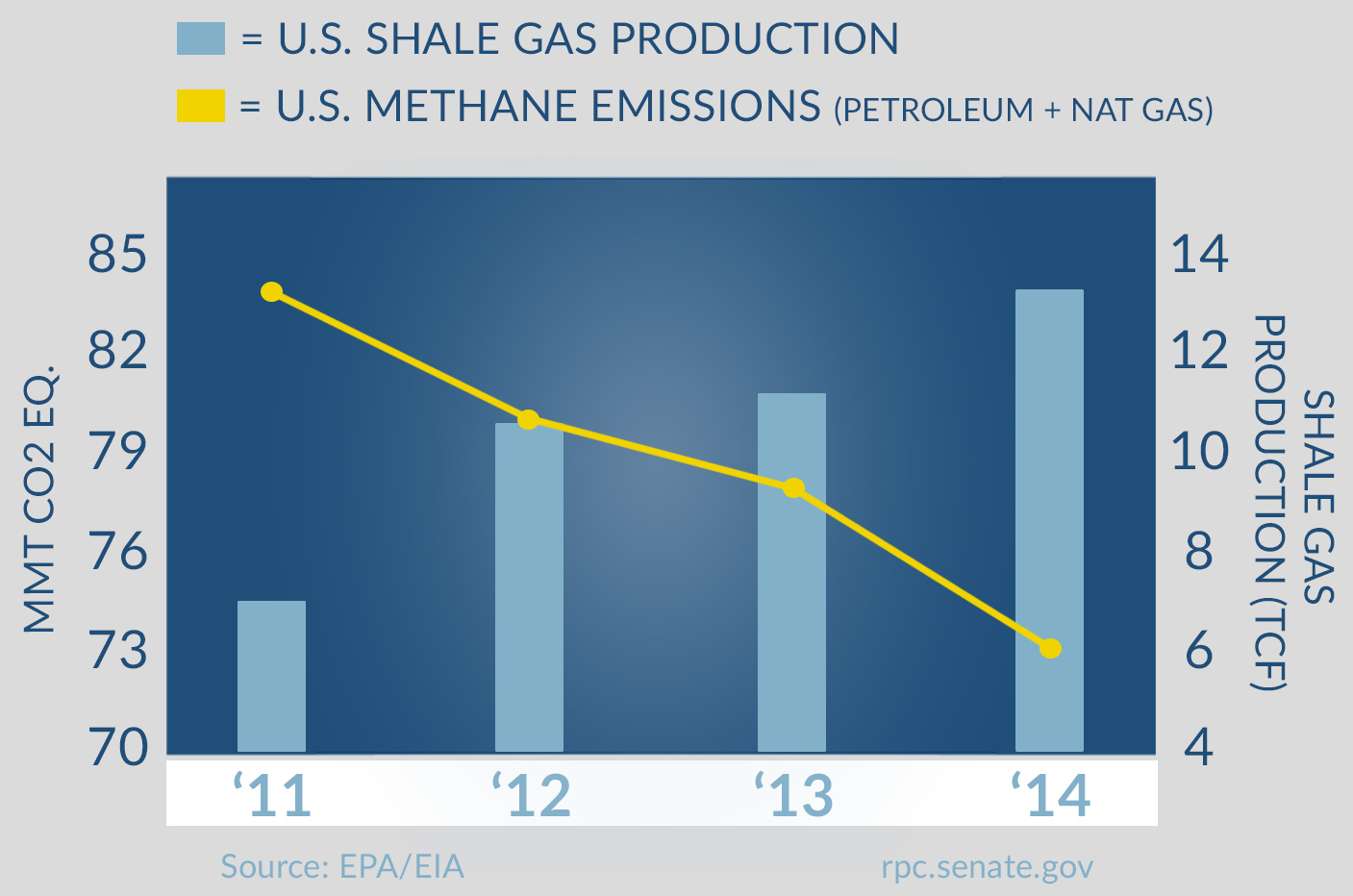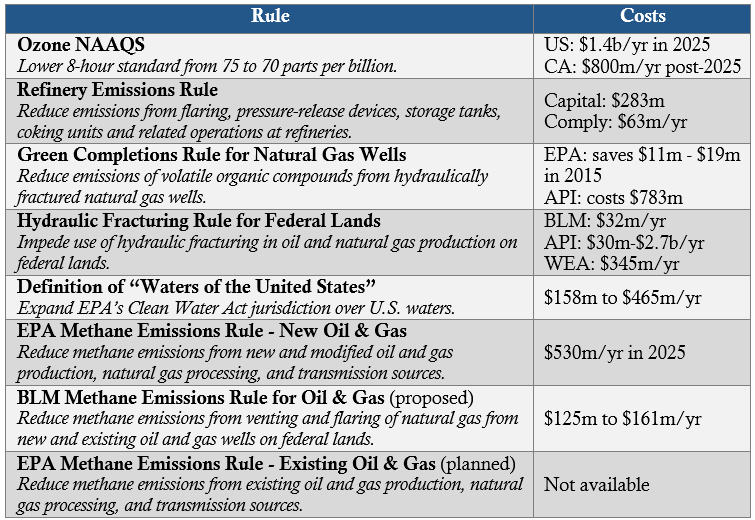EPA Methane Rule Harms Americans, Helps OPEC
- On May 12, the Environmental Protection Agency issued a final rule governing methane emissions from new and modified equipment in the oil and gas industry.
- The rule is unnecessary because America’s oil and gas producers are already voluntarily reducing their methane emissions, which makes good business sense.
- The rule adds costs to America’s oil and gas production that will harm America’s energy consumers and help America’s foreign competitors like Russia and OPEC.
At its biannual meeting in Vienna this month, OPEC continued its strategy of oversupplying global oil markets, harming America’s shale energy producers with low oil prices. OPEC should commend Washington Democrats for their help. The Obama administration’s new rule limiting methane emissions from U.S. oil and gas operations imposes higher costs on America’s shale energy producers. These costs will trickle down to energy consumers and further harm jobs.
Methane rule costly and unnecessary
The Environmental Protection Agency says that the final methane rule will cost $530 million per year in 2025. These additional costs will harm the ability of America’s shale energy producers to compete. The new rule is unnecessary given the oil and gas industry has dramatically reduced its methane emissions over the past decade, even as its operations have expanded.
Natural gas production rises, methane emissions fall – because it’s good business

America’s shale energy producers reduced methane emissions from petroleum and natural gas systems by 13 percent from 2011 to 2014, while shale gas production increased by 68 percent. Between 2005 and 2013, natural gas production rose by 26 percent, while methane emissions fell by 38 percent from gas production and by 79 percent from hydraulically fractured gas wells.
Federal regulations were not needed to create these emissions reductions. America’s shale energy producers took it upon themselves to innovate because it made good business sense. They found ways to capture methane at the wellhead, to reduce leaks of methane from pneumatic valves and other control devices, and to detect leaks of methane with advanced monitoring systems. Capturing more natural gas, which is mostly methane, means they have more product to sell. In 2012 alone, voluntary measures by the oil and gas industry to reduce methane emissions generated $264 million in additional revenue.
Jeopardizing Additional Methane emissions reductions
The one-size-fits-all final methane rule written by Washington Democrats threatens to stifle innovation and discourage investment in new technology that could lead to additional methane emissions reductions. The Independent Petroleum Association of America expressed concern that the rule appears “to remove flexibilities for producers and could actually undermine industry’s progress.” For example, the rule “largely locks in costly, handpicked monitoring technologies and suppresses the development of other approaches that could be more cost-effective and efficient.”
Washington Democrats profess concern about greenhouse gas emissions, yet in February they blocked a Republican proposal that would have empowered America’s shale energy producers to capture even more methane from their operations. Producers sometimes burn off excess gas as carbon dioxide or vent excess gas as methane straight into the atmosphere because there is not enough pipeline infrastructure to transport this gas to market. Republicans offered an amendment to the energy bill to require the Interior Department to expedite gas gathering lines on federal and Indian lands to help producers reduce flaring and venting. Forty-three Democrats filibustered the legislation, including some from energy-producing states: Senators Michael Bennet from Colorado, Robert Casey from Pennsylvania, and Martin Heinrich and Tom Udall from New Mexico.
Washington should provide America’s shale energy producers with maximum flexibility to continue innovating technologies and implementing strategies that help them reduce emissions. The final methane rule and others like it are not good for business or the environment.
Harming Americans
America’s shale energy producers have added roughly 4.4 million barrels per day of oil and 7.6 trillion cubic feet per year of natural gas to global markets since the beginning of 2009. This has slashed American energy prices and generated millions of new American jobs.
According to a report by Harvard Business School and the Boston Consulting Group in January, American households have saved $800 per year on electricity, heating, transportation, and goods associated with lower natural gas prices. It estimated that families saved another $750 in 2015 as a result of lower gasoline prices. These energy producers also added $430 billion a year to America’s GDP. The industry created more than 2.7 million jobs with average salaries twice the U.S. median and 50 percent of which are “middle-skills jobs, accessible to the average citizen.”
Another study released last year concluded that imposing unnecessary and burdensome constraints on oil and gas production would block hundreds of thousands of American jobs.
In less than four years, thousands of American jobs would be blocked

Anti-energy policies to constrain oil and gas production would block more than 800,000 jobs in 2020, and make gasoline and other petroleum products more expensive. In contrast, pro-energy policies to remove regulatory restrictions from oil and gas production would generate 400,000 jobs in 2020 and make gasoline and other products cheaper.
The Obama administration’s methane rule undermines the ability of America’s shale energy producers to continue delivering the economic benefits that consumers have come to expect.
Helping opec
Beyond economic benefits, there are geopolitical advantages to America’s shale energy production. It has weakened our adversaries and tempered OPEC’s dominance of oil markets.
Falling oil and gas prices undermine the finances of several American adversaries, whose budgets depend on energy revenues. Russia, Iran, and Venezuela needed oil prices well past $100 per barrel to balance their budgets in 2015. With falling oil and gas revenues, these countries are less able to pay for the government services they need to keep their regimes stable. They are in weaker positions when negotiating with the U.S. and other foreign powers over their military aggression, nuclear ambitions, and other provocative positions. At home and abroad, their power correlates with oil and gas markets – and it declines when oil and gas prices fall.
In addition, America’s shale energy production has introduced direct competition into global oil markets that has tempered OPEC’s dominance. Primarily controlled by Saudi Arabia, OPEC has traditionally managed the world’s “spare capacity” of oil, turning the flow on and off to lower or raise global oil prices. Last month, a former Qatari energy minister conceded that America’s shale energy revolution has stifled OPEC’s ability to balance the global market. Faced with surging U.S. production, OPEC’s apparent monopoly over the global market and its historical role as “swing producer” are in question. Experts from ConocoPhillips to Goldman Sachs to former Federal Reserve Chairman Alan Greenspan had already “anointed” America’s shale oil industry the world’s new swing producer in April 2015, according to a Bloomberg article at the time.
OPEC has been left sharply divided between the “haves,” who retain sufficient financial resources to withstand low oil prices – Saudi Arabia, Kuwait, United Arab Emirates, and Qatar – and the “have nots,” who lack sufficient financial resources to withstand low oil prices – Iran, Iraq, Angola, Nigeria, Libya, Algeria, Ecuador, and Venezuela. As a result, the organization is largely constrained from implementing a uniform oil production agenda. Russia, a major oil producing nation that is not a member of OPEC, is exploiting these divisions. According to an analysis published last October on OilPrice.com, Russian President Vladimir Putin is “strengthening Russia’s influence with OPEC. Russia already has extensive and close ties with Iran and Venezuela and is now laying the groundwork for such ties with Iraq. Putin has aligned Russia with OPEC’s “have nots” who also need higher oil prices. By forming a “Russian bloc,” Putin could be establishing a path to isolating Saudi Arabia and other Gulf members, exerting more influence over OPEC’s role in global oil markets, and expanding Russia’s sway in the Middle East.
By raising the cost of shale energy production, the methane rule could force American energy companies out of business. It could help to make our nation’s oil and gas less of a threat to OPEC’s market share, giving the organization an opening to restore its dominance of global oil markets, perhaps emboldened by a new alliance with Russia.
a threat from within to oil and gas
The final methane rule is the latest in a series of executive actions that Washington Democrats have taken, and plan to take, to constrain America’s shale energy revolution. The following are just some of the regulations Washington Democrats are pushing through the regulatory pipeline.
Democrats’ war on oil and gas continues
These regulations do not include other policy initiatives pursued by the Democrats to block oil and gas infrastructure, to prohibit oil and gas production on federal lands, and to otherwise dis-incentivize oil and gas consumption.
In March, Hillary Clinton promised to regulate hydraulic fracturing out of existence, saying that “by the time we get through all of my conditions, I do not think there will be many places in America where fracking will continue to take place.” In February, she pledged that banning fossil fuel production on federal lands would be “a done deal” if she becomes president.
A foreign policy analyst at the Niskanen Center summarized it best in a commentary published by The New Atlantis in April: “At present, the world crude oil market is clearly serving U.S. interests admirably, with various factors, including the core of U.S. tight oil producers, coming together to restrain oil prices. It’s strange, then, that President Obama has lately adopted an adversarial tone toward domestic oil producers … Perhaps U.S. oil producers and oil consumers should focus less on the supposed threat posed by Riyadh and more on that posed by Washington.”
While the threat to America’s shale energy producers comes from within America’s borders more so than from our competitors overseas, it certainly does not have to.

